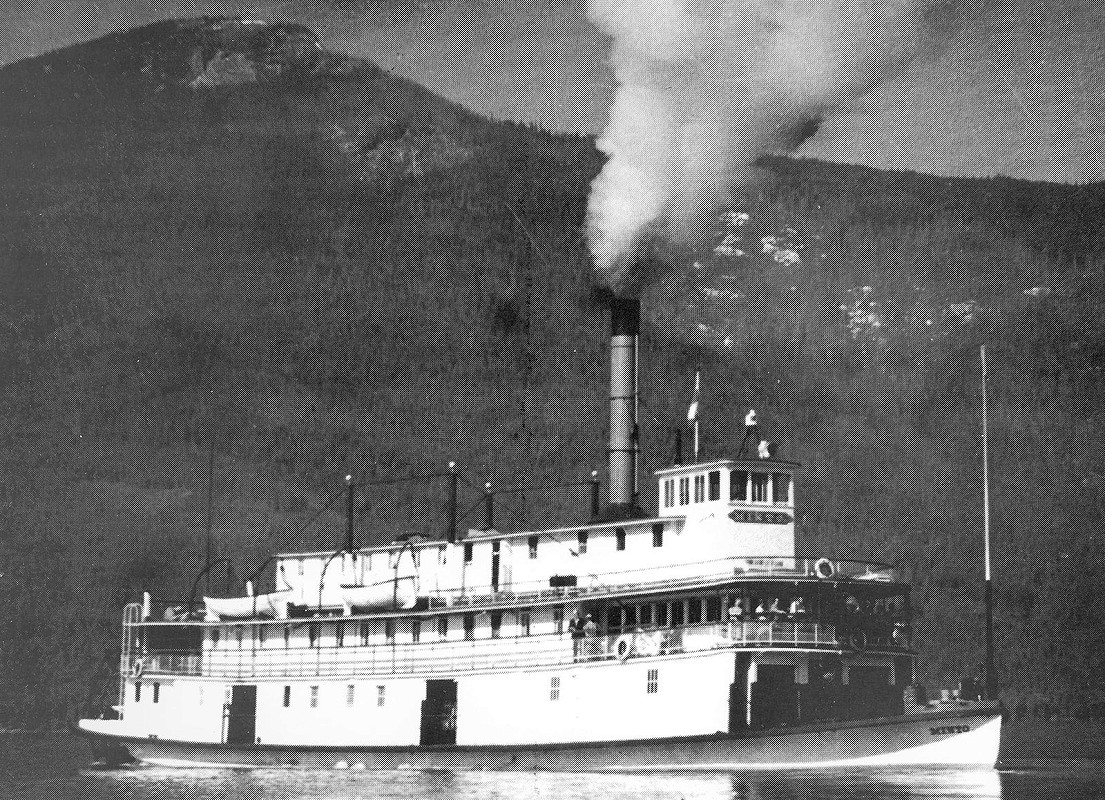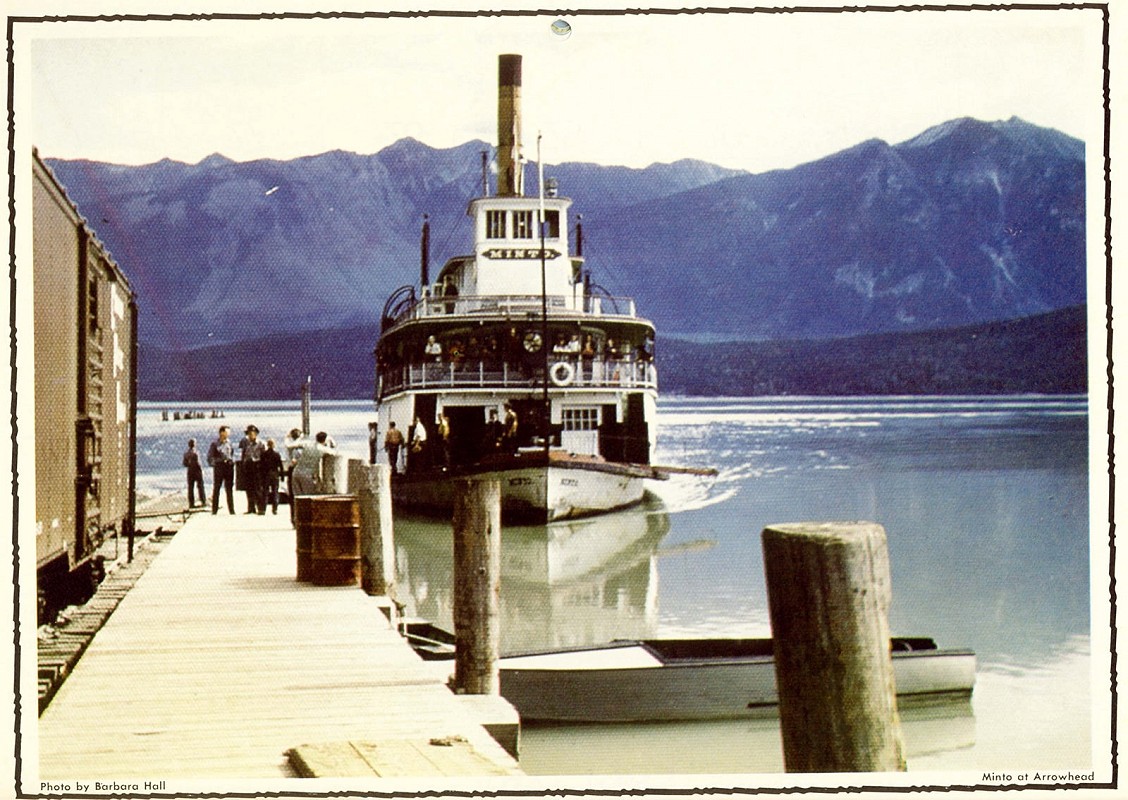CPR’s Branchline Below Water A Story of the Now-Submerged Arrow Lake Track
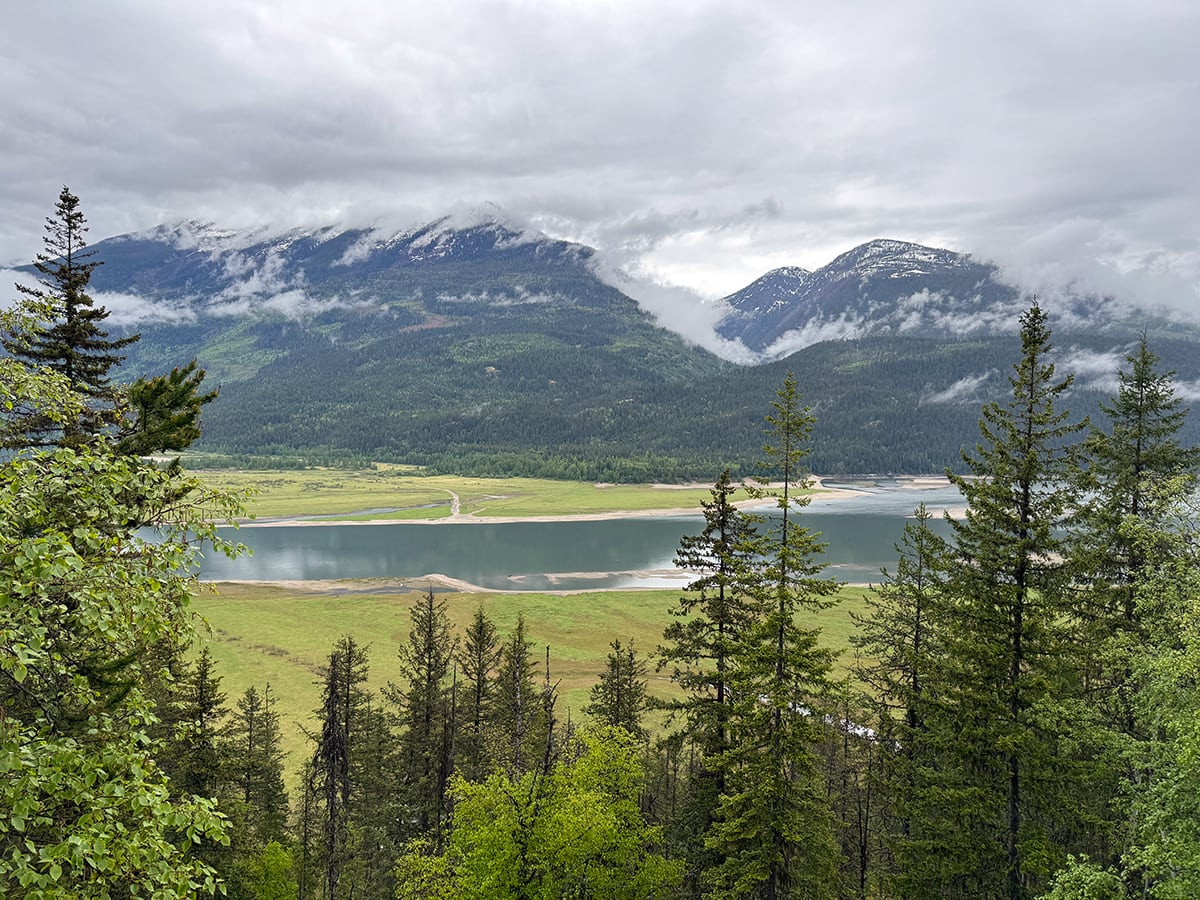

As a specialist in western history, lately I find pleasure in visiting railway sites now diminishing in public memory — becoming history even as I write for Branchline.
Just by living long enough, one seems to acquire a sort of wisdom or knowledge of value, at least for those of like ilk.
I find myself in an era wherein I can still find retirees with memories of places I recognize, or know, but sometimes never visited during its years of activity.
Some topics have become exhibits in museums — an indicator of my own advancing age! Just by living long enough, one seems to acquire a sort of wisdom or knowledge of value, at least for those of like ilk.
My self-perception is that of being a mere raconteur of rails, a scribe of steam, or a distiller of detail. So herein I present a historic railway, disappeared from British Columbia’s beautiful Columbia valley.
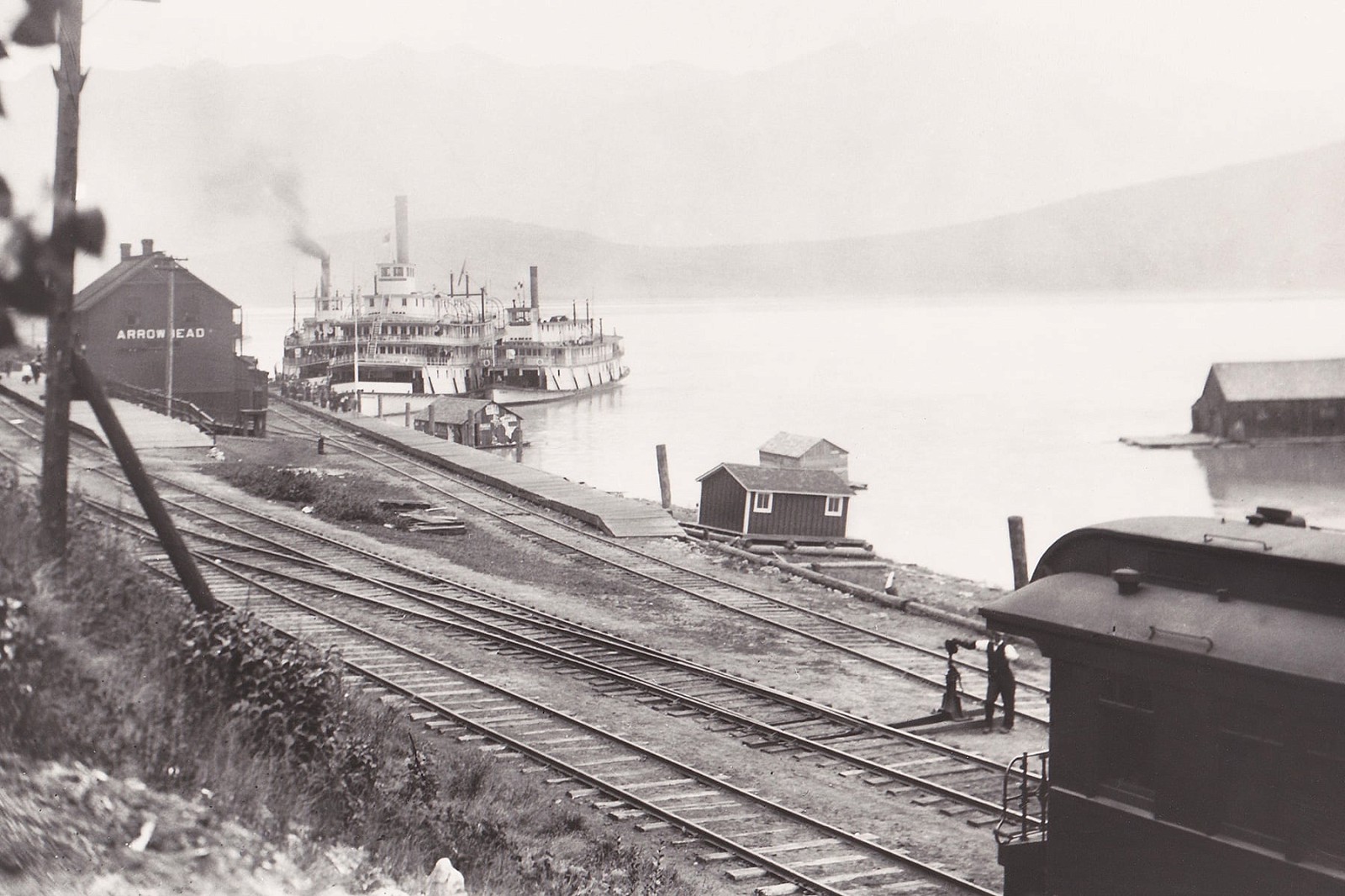
Circa 1912 on the waterfront at Arrowhead. CPR sternwheelers (L to R) Rossland, Bonnington, and Minto. After 1931, SS Minto was one of two of the last operating paddlewheelers in passenger service in the Pacific Northwest (the other being sister SS Moyie on Kootenay Lake). Note the buildings designed to float on the fluctuating lake. Vancouver Public Library 16773, photographer unknown.
The Arrow Lake Track
This story is about the CPR branchline which once ran from my hometown of Revelstoke to the head of the Arrow Lakes.
Arrowhead was a small town on the northeast shore of a widening of the Columbia River, 27 miles south of Revelstoke. It was the northern limit of year-round steam navigation on those large interior lakes. Steamboats operated by the CPR were once part of a service which linked lakes and towns between the national mainline and the southerly Crowsnest line. The longest water route was from Arrowhead to Robson, opposite the modern city of Castlegar, a distance of 127 miles.
Earlier, other steamers even operated south into Washington State. At each dock, passengers and freight were trans-loaded to trains bound for Revelstoke or for Nelson, respectively. There was also a branchline to Trail, site of a smelter, much later named Cominco, and purchased by the CPR.
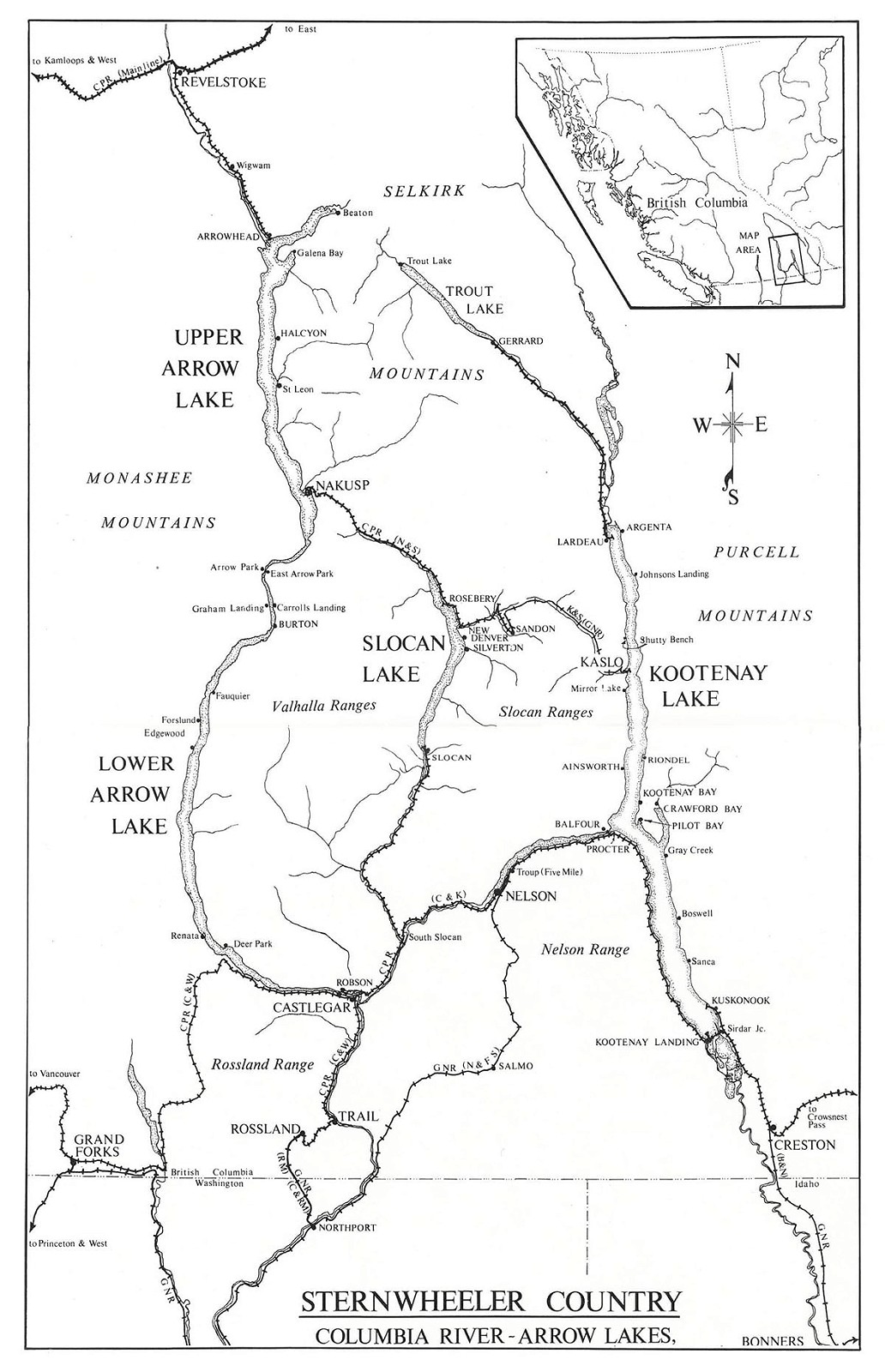
Map courtesy of RD Turner. This illustration originally appeared in Turner’s Sternwheelers and Steam Tugs: An Illustrated History of the Canadian Pacific Railway’s British Columbia Lake and River Service. The book is no longer in print.
An Empire Threatened
This transportation system was built gradually, timed to serve population growth plus mining and lumbering enterprises which drove early development in southeastern BC. Factors such as terrain and climate caused setbacks, but prospects of profit steadily drove the CPR to ongoing investment, especially in competition with rival US road, the Great Northern.
They duplicated similar services within the same territory, but naturally took profit to their home country, much to the consternation of the CPR Board of Directors.
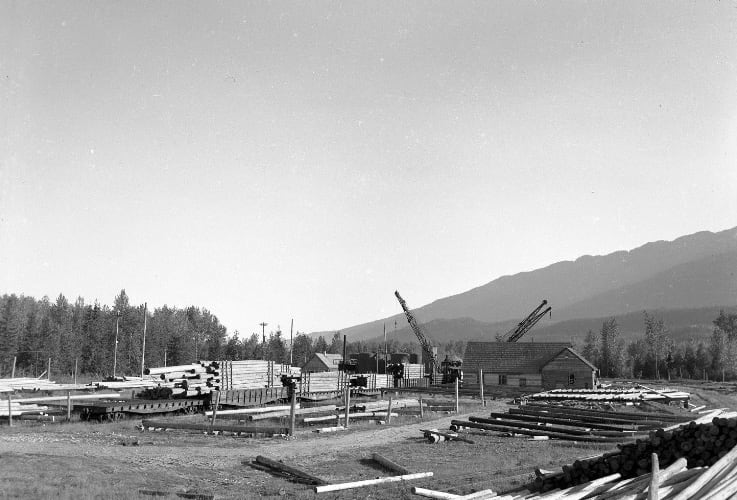
Arrowhead Wood Preservers Ltd., a pole yard two miles south of Revelstoke, circa 1950. Owned by Penta Pole company of Minneapolis MN. Photo © late E Dickey.
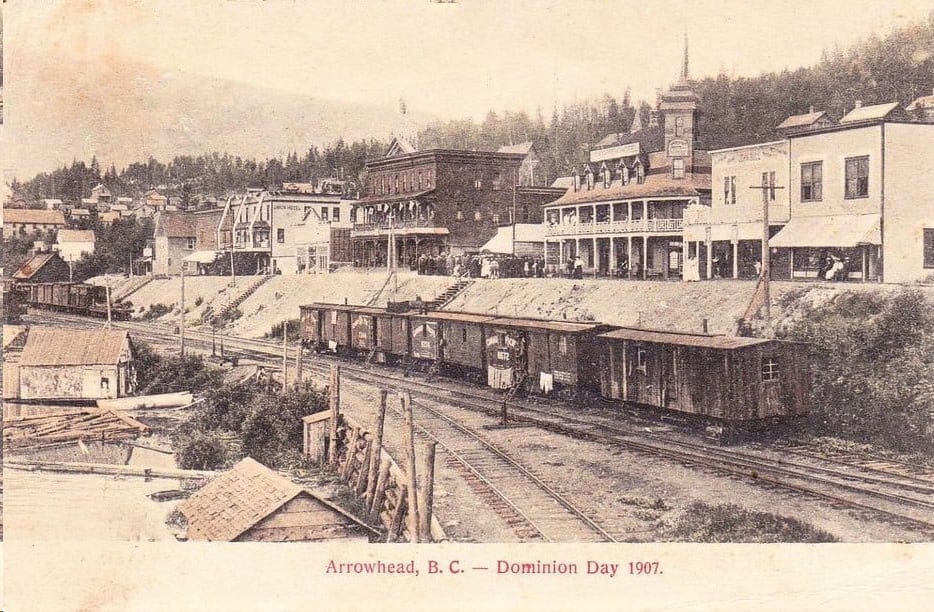
Postcard of Arrowhead on July 1, 1907. The town and the railway were squeezed parallel to the lake by steep mountainsides behind. It was Dominion Day before becoming Canada Day in 1982. Someone in the bunkcars has decided to use the holiday to do laundry! Photographer unknown.
Steamboats on the Columbia River came up from the United States as early as 1865; SS Forty-Nine delivering supplies and gold prospectors to the ‘Big Bend’ country, upriver from Revelstoke. This same vessel was later used by CPR surveyor Walter Moberly to ferry supplies to his crew at the mouth of Eagle Pass in late 1871 (opposite the as-yet-unnamed Revelstoke). It was another 14 years before supplies would come up from Washington State for CP railway construction.
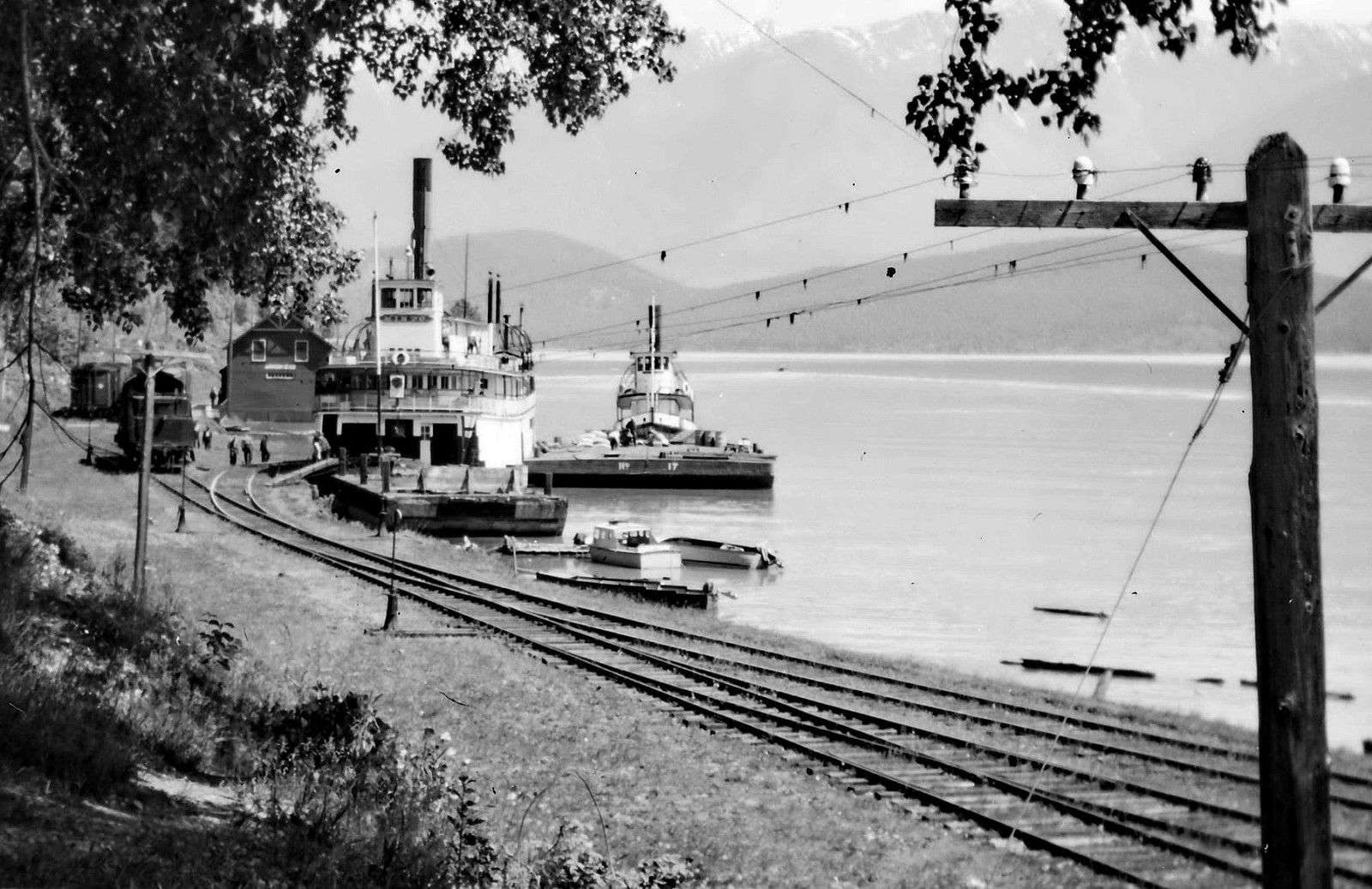
High water suggests this photo was taken in 1948 because the station is inundated. Passengers had to disembark via a gangplank directly to the tracks from the SS Minto. To her left, the steam tug Beaton with her dedicated barge await freight and walk-ons. Photo © late Ida Crawford.
Hardrock mines soon developed along the mainline (Field and Illecillewaet, BC being early examples), and also in the Kootenay region to the south. Everybody figured to get rich, if not in mining, then in smelting ore. English financiers blew in a smelter at Revelstoke worth over $50,000 in 1891.
Everybody figured to get rich, if not in mining, then in smelting ore.
Newspaper editors urged entrepreneurs on with lyrical entreaties: “Nearly every stream running into the Columbia carries float gold.” (Inland Sentinel, 19 October 1889).
This bit of ‘news’ was two decades past the former placer rush, but no matter. Even editors in other regions wanted to promote ambitious projects as evidence of regional progress:
It is stated on reliable authority that construction of the first section of the Revelstoke and Nakusp Railway is to be commenced at once. This section is from Revelstoke to the Northeast arm [Arrowhead], 25 miles for which $3,200 per mile has been appropriated by the Dominion Government. It is also stated that six mines from Revelstoke to the big sandbar will be completed this fall.
The table below shows the main features of the route by mileage from Revelstoke to Arrowhead.
| Trackside Mileage | ||
|---|---|---|
| Revelstoke | 0.0 | station, yards, shops, “South hole” |
| Illecillewaet River bridge | 1.3 | through truss, 159 feet |
| Begbie | 2.3 | station - name later reapplied elsewhere |
| Six Mile (local name) | farming community | |
| Mount Cartier (local name) | 7.5 | farming community |
| Greenslide | 9.7 | 1,003 ft. siding |
| Twelve Mile (local name) | 13.4 | water tank and spur |
| Wigwam | 17.0 | station, freight shed, 1,047 ft. siding |
| Pile trestles | 17.4 — 21.8 |
nine trestles, 1,200 ft. total |
| Tank Creek | 19.5 | water tank |
| Twenty-one Mile (local name) | station and spur | |
| Sidmouth | 24.1 | station (boxcar minus wheels), 600 ft. siding |
| Arrowhead | 27.5 | station, water tank, 6,604 ft. sidings total |
Transportation Struggles and Railway Developments
Meantime, the new smelter was experiencing erosion from the Columbia River, which eventually undercut its property so badly the whole damn works washed into the river in 1898. Steamboating also proved problematic, what with ice obstructions, fast-flowing high water, and hidden sandbars.
The public wanted more convenience and shippers wanted to keep product moving, especially sacks of ore bound for other smelters in the south. The river between Arrow Lake and Revelstoke soon proved unsuitable for year-round transportation:
Track laying on the Revelstoke and Arrow Lake railway was progressing satisfactorily in a permanent, substantial manner. The materials used for the construction were all in good condition and the roadbed for nearly the whole distance was desirable.
Such a vague report shows little editorial idea of what is really happening. Work ceased for the winter on the 10th of November that year. Shortly thereafter, an accident emphasized that transportation complaints had validity:
The steamer Illecillewaet came to grief at Green Slide on Sunday morning last. When proceeding down the Columbia River she struck a snag at that place and went down. She had on board two cars of flour for Nelson. Further particulars have not arrived.
Then, on 2 February 1894, train service was suspended to Greenslide. The river had become too low for navigation, and boats could not operate. For a period, all supplies bound for southern points had to be teamed to the head of the lake for hand-bombing onto steamboats up bow-landing gangplanks. River service to Greenslide resumed in April, as did track work.
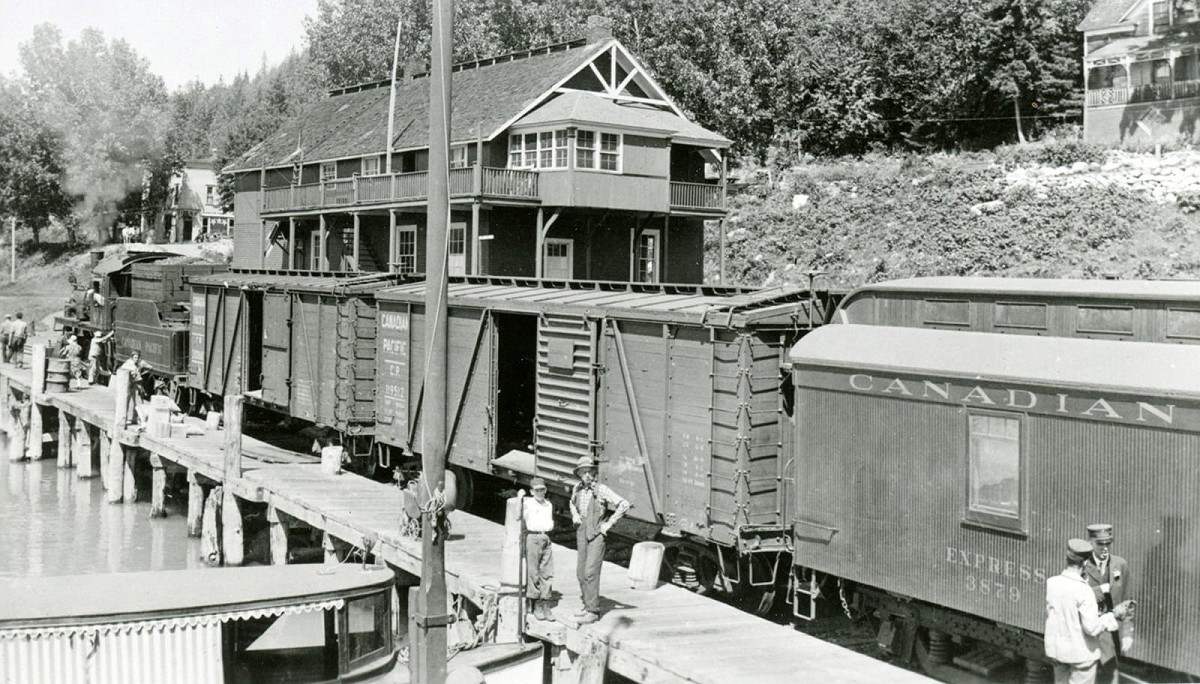
In later years, the usual consist was just a baggage car for freight, a day coach, and a caboose for crew. Amongst the baggage were always a few large blocks of ice from the Revelstoke icehouse for use in the Minto’s galley. The trip took almost two hours due to restricted track speed. Loco #444 was on this route until she was withdrawn and scrapped in September 1946. Thereafter, #443 took over, but #447 also did duty. All were D4g’s. Photo © late Ida Crawford.
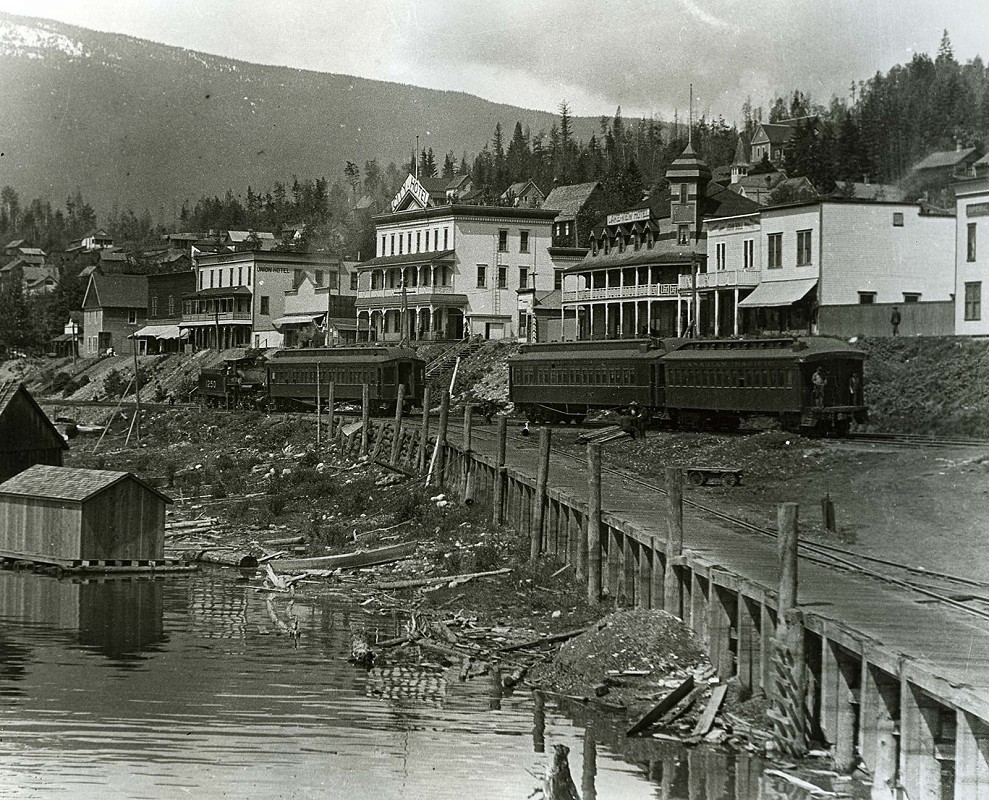
Arrowhead as it appeared, rebuilt, about 1910. Loco 1250 shunts coaches for the arrival of a steamboat. The Union, City, and Lakeview Hotels await clientele. Photographer unknown.
So, cautiously, the CPR agreed to build a branchline, but not as far as the Kamloops editor advocated. The number of railway charters granted in those days, in addition to wild Board of Trade proposals, is beyond comprehension. One speculator even proposed an independent railway from the Kootenays to Hudson Bay! Still waiting for industry to provide profitable freight, the CPR placed a terminal at Wigwam, today little more than a mudflat:
Track laying on the Arrow Lake railway has reached a point 13 miles below Revelstoke. Terminal facilities are being arranged south of Wigwam.
. . . the Columbia has frozen in some places and the steamer Lytton has been obliged to land at the head of the Arrow lake instead of coming to Wigwam where the Revelstoke & Arrow Lakes railway depot is. Communication between the railway and the steamer is being kept up by means of teams engaged in hauling principally ore, but passengers when necessary. For a few weeks past men have been engaged in making a sleigh road on the route and had just got nicely completed when the weather turned cold enough to freeze the Columbia river.
Revelstoke May 29, 1895 — Messrs. Stewart and Richardson, the C.P.R. surveyors, arrived in Revelstoke from the east last week, and left on Monday for Three Forks, where they will be engaged surveying the proposed extension of the Nakusp and Slocan railway from Three Forks to Sandon, a distance of about five miles. It is expected that when that work is done their attention will be turned to the extension of the Arrow lake branch from the Wigwam.
Ever vigilant to scraps of speculation, the Kamloops paper seized on this observation from those who must be ‘in the know’:
Tinhorn gamblers have begun to gather in Revelstoke in anticipation of railway construction.
Then, properly reported a week later:
Contracts for completion of the Revelstoke and Arrow Lake branch were let on Tuesday. Dan McGillvray’s tender which was the lowest, was accepted, and $150,000 is to be expended in completing the railway, which will be finished as soon as possible, so as to allow uninterrupted connection between Revelstoke and the lower country.
Construction crews were housed in bunk cars, but sometimes in tent camps. Field investigation by this author in the spring of 2023 revealed a former encampment, today completely forested, where still stands a stone oven. It’s calculated to be 129 years old. Older and younger examples found elsewhere in BC indicate where construction progress paused long enough to make an oven’s erection worthwhile. Or maybe where camp cooks were particularly generous to helping masons!
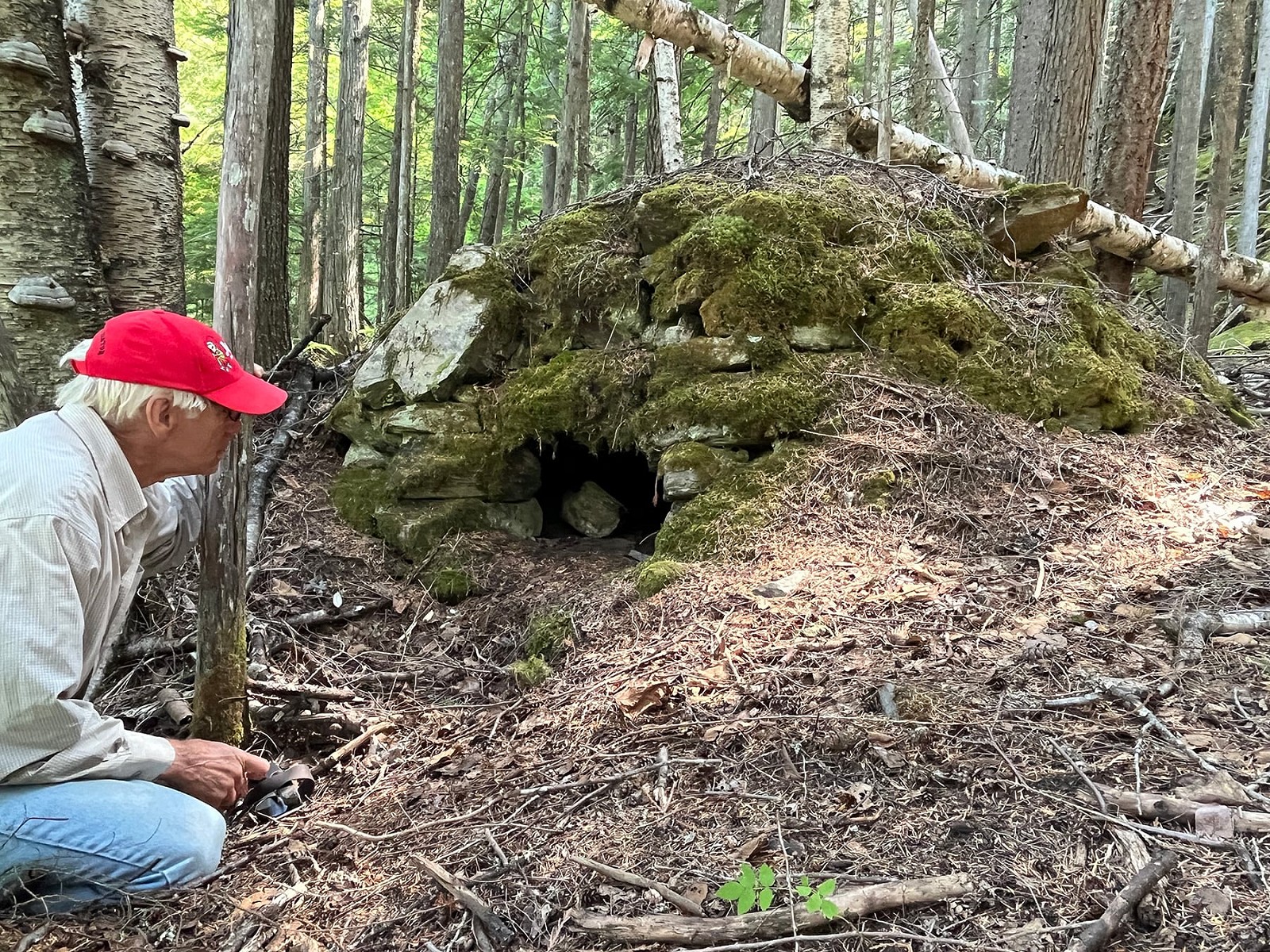
Examining an overgrown (but intact) stone oven left by railway construction workers near Wigwam. Others are known along the CPR mainline. Author Parkin is conducting research into oven distribution, construction style, and baking use in western Canada. This one dates from 1895, and may have been used for a few weeks when blasting temporarily slowed the southward progress of the roadbed. Photo © TW Parkin.
Arrowhead townsite was initially surveyed in 1895 and soon became a trading centre for miners, loggers, and farmers. The first building erected was the Lakeview Hotel, followed by a general store, drug store, bank, two churches, a school, and a hospital by 1905. Boat crews are recorded in community directories of the era, but train crews were always based out of Revelstoke.
By March 1896, a 60-foot x 30-foot
station plus a 60-foot x 24-foot freight shed were put up. Track to the
wharf had a 2% grade so boats could unload at any lake level. While
ballasting wasn’t yet complete, the line was deemed safe if trains kept
below 12 mph.
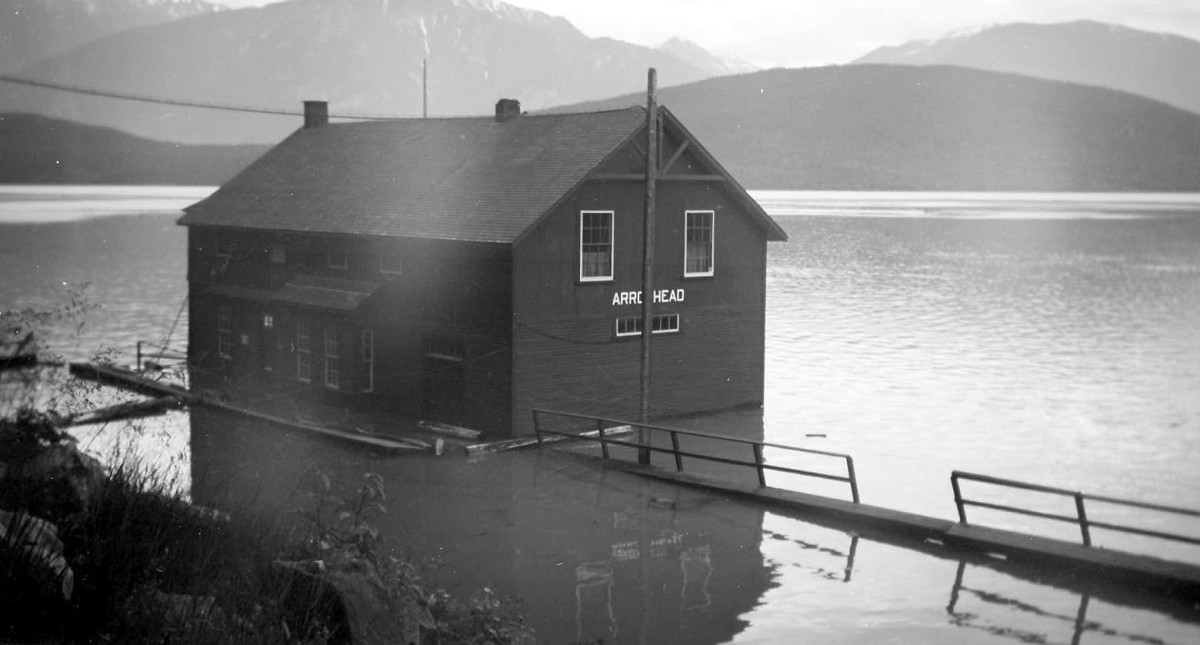
The 1948 floods inundated the dock, station, and branchline so badly that rail service was suspended and the station required rebuilding. It was an unpredictable, but ongoing, problem. A sign on the building’s second floor once said “High water level, 1894”. Photographer unknown.
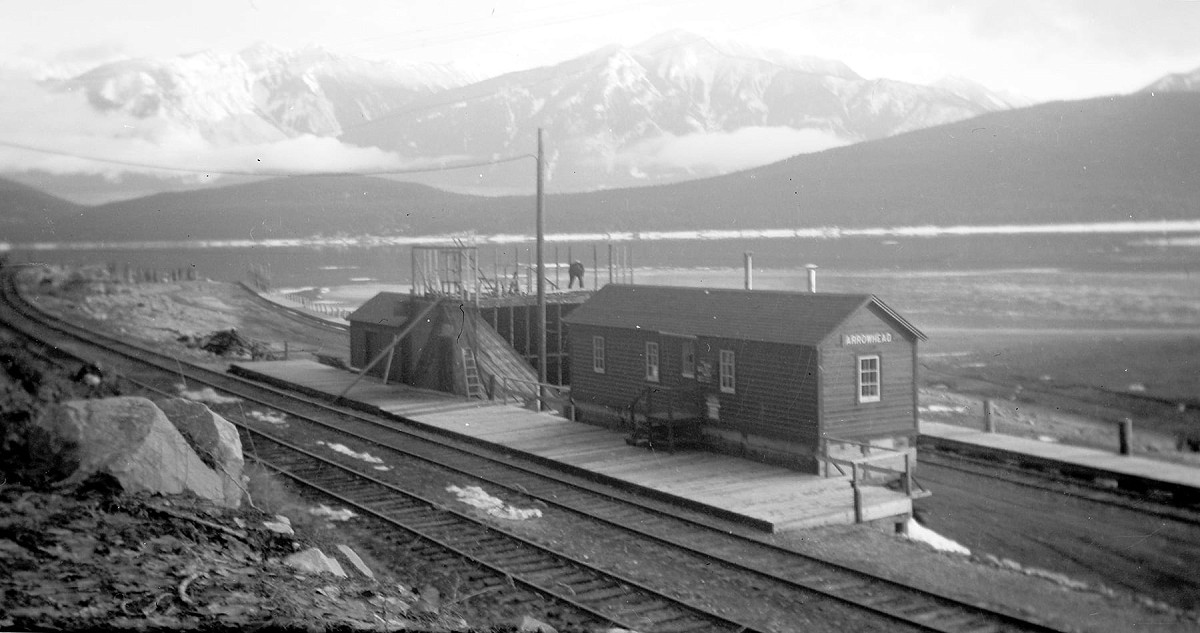
Early in 1949, the original damaged station was rebuilt, as shown here. The appearance of mudflats behind indicates the rise of lake level the year previous. This little station served only 11 years before it closed. Thereafter, there was a Tuesdays-only freight service. Photo © late Ida Crawford.
No sooner was everything going swimmingly than in July 1896, the Columbia’s spring freshet flooded the line.
The Miner newspaper at Nelson reported SS Nakusp as busy on the Arrow Lakes. The Columbia & Kootenay Steam Navigation Company built the tug Columbia in 1896 to power rail barges on Arrow Lake to relieve steamboats of this duty. Completion of the Arrowhead branchline didn’t negate navigation troubles, however.
No sooner was everything going swimmingly than in July 1896, the Columbia’s spring freshet flooded the line. The Illecillewaet River bridge washed away, and damage was so severe the line didn’t reopen until the end of September. To compensate for the traffic interruption, the Nakusp again ran all the way to Revelstoke. Periodic, but damaging flooding was to become an ongoing problem throughout the region.
The C.P.R. have now a large gang of men employed at Arrowhead putting in a new wharf, taking up the old track, and replacing it for the better handling of the transfer of freight from the cars to the steamboat. The rock used for the construction of the wharf is taken from the old tunnel on the Bald Eagle mineral claim. Roadmaster Newman is in charge of the work.
Canadian Capitalists Succeed
By the look of such reports, the CPR had regained confidence lost during the economic depression of 1893-97. This period is recognized as the worst in US history, and caused collapses in the rail industry in particular, which had grown irrationally, driven by the interests of wealthy classes in a monopolistic environment.
The CPR survived, and at the end of 1896, announced it would acquire all the boats and plant of the Columbia & Kootenay Navigation Co., thus positioning itself to dominate the shipping trade. This topic would fill a book, and it has. Read Robert D Turner’s 1984 title Sternwheelers and Steam Tugs: An illustrated history of the Canadian Pacific Railway’s British Columbia Lake and River Service.
As it had done with its mainline and marine operations, the CPR moved in concentric inclusions. For example, it established hotels for stay-over passengers at Revelstoke, and later, a resort hotel at Balfour on Kootenay Lake.
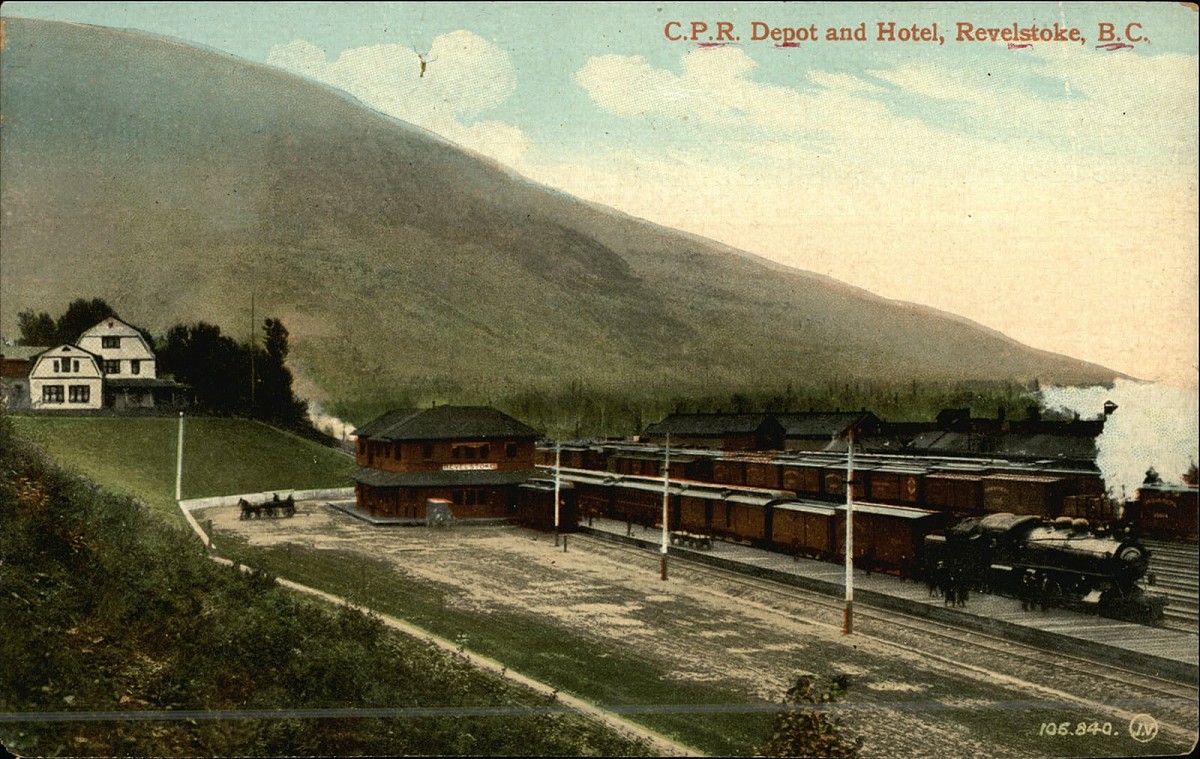
CPR station and Hotel Revelstoke (left), 1910. The spur immediately behind the whitewashed poles is still known as “the South hole.” A coach bound for the next trip to Arrowhead awaits assembly into that daily train. Postcard by Valentine & Sons, Ltd.
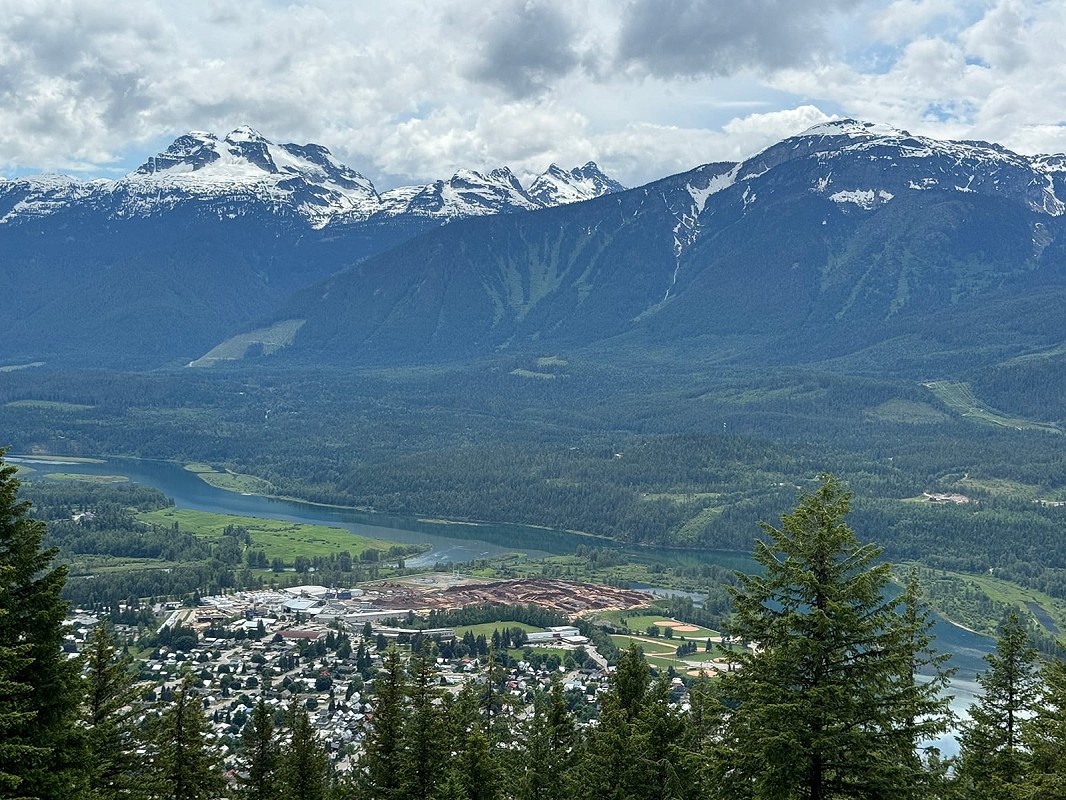
The modern city of Revelstoke lies at the confluence of the Illecillewaet and Columbia Rivers, between the Selkirk and the Monashee Ranges. Seen here in April 2024, before the reservoir backed up behind the Hugh Keenleyside dam. Photo © TW Parkin.
Significant to this story is Hotel Revelstoke (1897-1927). It stood on the bench of land behind the present station. To reach lake-bound coaches, transferring passengers walked down a staircase and along the platform to a spur track which still exists today. Railroaders called it “the South Hole.” But it didn’t point in any such direction. Few now know this is where southbound trains once assembled prior to embarkation.
It is reported that the C.P.R. intends as soon as the ice forms on the Arm to commence construction work on the branch line from Arrowhead through the Lardeau to the head of Kootenay Lake. It is said that men have been engaged for the rock work which will have to be done on the Arm. A few miles from Arrowhead . . . The engineers regard the line as an easy one to build . . . Large quantities of freight and heavy machinery keep being poured into South Kootenay through Arrowhead. The Rossland and Kootenay [paddlewheelers] are frequently loaded down to their utmost capacity.
Such reportage was a revival of the boosterism which had put one fourth of all US rail mileage into receivership during ‘the Panic’ of 1893-97. Might you recall the phrase “irrational exuberance” popularized by former Federal Reserve chair Alan Greenspan in 1996? Same warning applies here, in 1898.
The CPR was under constant pressure to extend the Arrowhead line eastward, through valleys containing Trout and Kootenay Lakes. It was mostly a “build it and they will come” philosophy. CP did build a short line between Lardeau and Gerrard, but it was out of service much of its lifespan and abandoned in 1942. In this instance, it was real estate speculators and mining promoters who lost their investments. Cooler minds focused elsewhere:
The Arrow lakes are destined to become the scene of great lumbering and industrial enterprise. Already five mills are erected or in course of erection on Upper Arrow Lake, and Arrowhead is likely to develop into a great industrial center.
J.S. Dennis, C.P.R. land commissioner accompanied by J.D. Siband, the C.P.R. land agent at Revelstoke, visited Arrowhead Thursday and closed several sales of lots. Practically the whole of the old C.P.R. townsite at Arrowhead has now been taken up.
By this time the CPR was advertising the wonderful land of the Arrow Lakes in the Vancouver area in hope of attracting farmers and ranchers. The town was growing in conjunction with a boom in lumbering:
Already in 1903, the scarcity of merchantable timber in the northeastern portion of the State of Washington was forcing . . . American capitalists to look to Canada for wood. In Arrowhead, James, Theodorre and Wallace Ludgate, who had come from the eastern states by way of Seattle, arrived to begin installation of a large mill right in front of the townsite . . . It was the first major industrial installation Arrowhead had received.
Spoils To The Victor
It joined several other sawmills already operating in the general area. The prosperity they brought made the wait for the railway worthwhile. In 1905, one of the mills had a daily output of 140,000 feet of lumber. Across the lake at Galena Bay, the Arrow Lakes Lumber Co. built a logging railway in support of their mill at Arrowhead. Saw and shingle mills, plus pole yards, continued to be a part of Arrowhead’s economy until the community was abandoned in the late 1960s.
Arrowhead is blooming into importance. The C.P.R. recognize this by the extensive improvements, and large yard they are providing. The steam shovel is at work filling in the frontage to the lake between the present track and the lake shore, and the main line will be pushed out to the shore, while between that and Main Street will be an extensive yard with not less than three tracks. J. Fraser’s bridge gang is also at work here, as well as an extra gang laying the line with heavier steel in view of the increasing traffic.
During the month of April 1906 in the neighbourhood of 240 cars of lumber were shipped from the two mills in Arrowhead, about 170 of them from the Arrowhead Lumber Co.
Then, wouldn’t you know it, a new disaster struck. In their rush to wealth, nobody had adequately prepared the civic water and sewer systems. Pipes had been laid, but no hydrants installed.
In their rush to wealth, nobody had adequately prepared the civic water and sewer systems.
In classic western form, the citizens burned da joint down around their ears without a hose in stock. Such a story was repeated time after time around BC, starting with the CPR’s own accidental ignition of the entire City of Vancouver in 1886. Twenty-one people died that time; none at Arrowhead:
At half-past one o’clock on Thursday morning an alarm of fire was given at Arrowhead, the cause being an outbreak in Reid & Young’s store . . . Just then a quantity of coal oil stored in the alley was caught fire and in an instant it spread through the big store rendering the saving of the goods an impossibility. The fire then spread to the City Hotel on the east side. Then the cigar store and then the Union Hotel . . .
A bad state of affairs prevailed in Arrowhead during the fire. Two cars of dynamite were left standing in the yard with sparks flying over them. The C.P.R. authorities were appealed to move them, but did not do so until the fire was about over. Had that dynamite gone up the results can be better imagined than described.
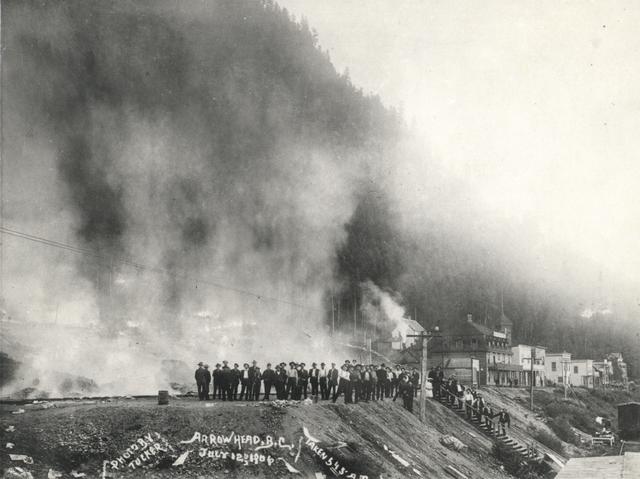
The morning after the fire of July 12, 1906, the men of Arrowhead assembled like conquering heroes for a photograph, even though there wasn’t a thing they had done to save their business district. Not a woman is in sight in this display of masculine bravado. What did they think of it all? Photo by EJ Tucker.
The railway was not affected. Rebuilding proceeded immediately, and the editor of Revelstoke’s Mail-Herald commented that all three hotel rebuilds were done with oh-so-shiny electric light! Unfortunately, the 1906 event wasn’t the only fire to destroy part of town or its mills.
The Arrowhead branch of the C.P.R. is becoming more popular every year, not only in the amount of freight carried, but also in the number of passengers that go up and down, practically all year round. The present Arrowhead train consists of a freight with two or three passenger cars hitched on the tail.
ICE-BOUND KOOTENAY
The unprecedented spell of severe weather through which this whole continent has been and is still passing, is having a serious effect on transportation companies both in Canada and the United States. Locally at Revelstoke, East and West trains are being continually held up by snow slides, while transportation to the south is completely ice bound. On Thursday and up till today communication with Nelson, BC was practically cut off. Passengers who left Nelson in the morning for the Coast via Arrowhead to Revelstoke had to walk into Arrowhead over the ice. There was no communication between Arrowhead and Nakusp, the ice being of unusual thickness and extent. A joint effort will be made by the S.S. Rossland and S.S. Kootenay to break a passage and the ice breaker [a barge with metal sheeting on the bow] will be called into requisition. A portion of Slocan lake has frozen over for the first time in 13 years.
As comparing this 1908 winter with that of last year, in looking up old files we find the following for February 8th, 1907. One rotary snow plough lost, one snow plough broken down between the [Columbia River] bridge and the [Revelstoke] depot. Telegraph communication cut off both ways. Slide at Greenslide 30 feet long and 20 feet deep, slide at Albert Canyon 24 feet deep and 125 feet long. No trains from west for two days, five, six and seven trains from east not in. Boats on Arrow Lakes frozen for four days. This will show what the C.P.R. has to contend with in winter and yet keep up the train service.
From 1908 until 1928, immigrants from the Ukraine settled on small farms, seven to ten miles south of Revelstoke. They cleared land and often built their first homes from logs they cut and hauled themselves. The women did much of the work tending fields and stock while the men supplemented their income by working for the Department of Highways or the sawmills.
Many also trapped fur to maintain year-round cash flow (winter fur being of highest quality).
As Ruby Nobbs implies, another economic shift was happening, one which accelerated toward and during World War I. Before WW I, one mill at Arrowhead was said to be the largest in the British Empire. But big mills on the coast, which provided cheaper lumber nearer to markets, were also coming on-stream. The frequency of commercial and industrial fires around the Arrow Lakes were often combustions of convenience. By 1920, public roads were infiltrating the hinterland. The trend in employment became subsistence farming and small mills.
A bit of employment fun occurred in 1936, when the Gaumont-British Picture Corp. came from England to film a movie about the construction of the CPR. Hundreds of local ‘extras’ obtained parts in crowd scenes. One location involved a cowboy chase near Greenslide, using the original CPR locomotive that made the first crossing of the country (see Branchline cover, Sept/Oct 2022). Watch the original film on YouTube under the title Silent Barriers, but know it has no historical authenticity, despite including familiar characters.
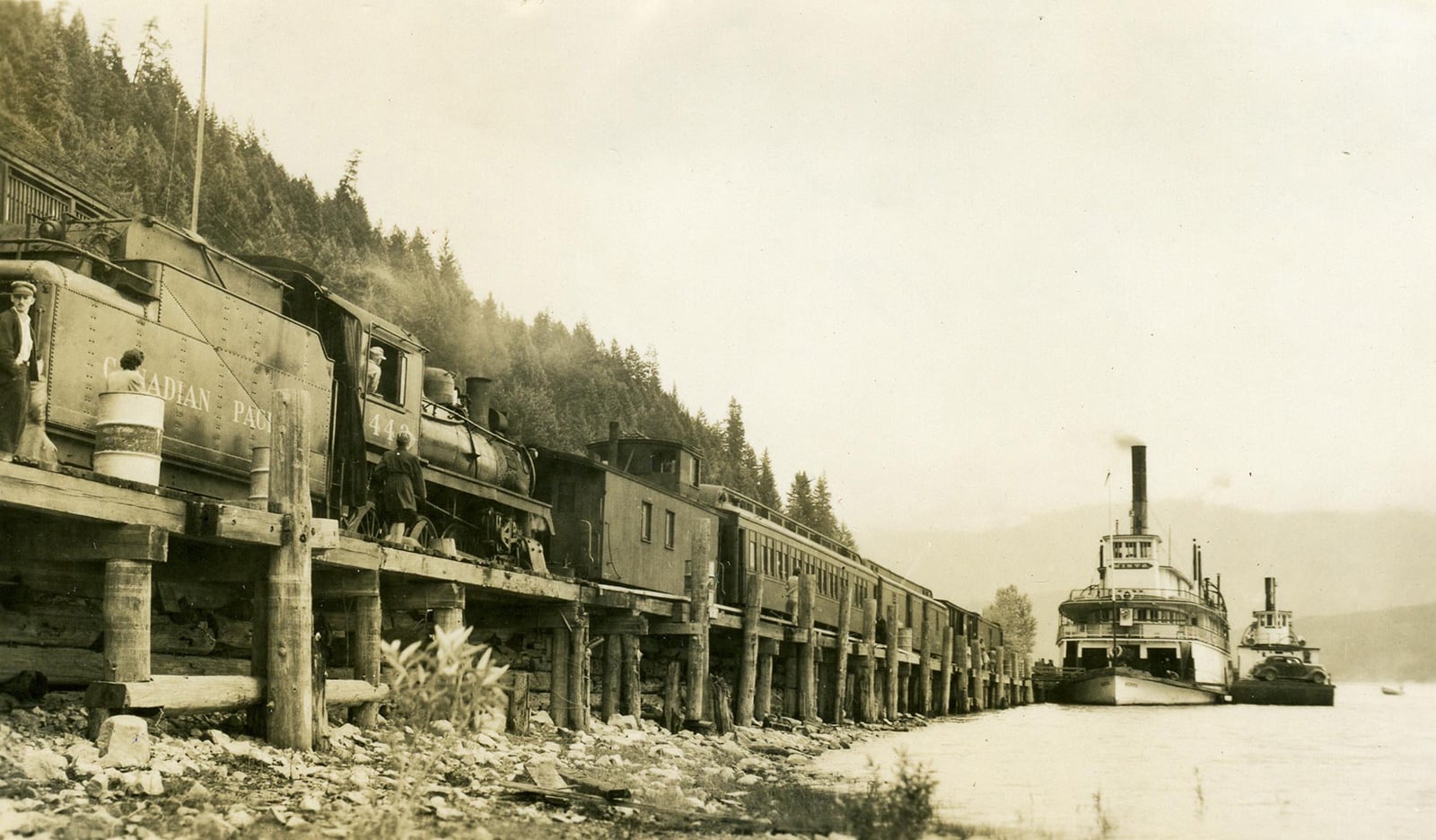
The date is 9 August 1947 as CP 443 pushes her mixed train down the steep dock to SS Minto and the tug Beaton, herself pushing a small barge with vehicles. In this configuration, the head-end crew will rotate the engine on a turntable so it will run pilot forward, but must couple the caboose to its tender for the return trip. Photo courtesy Washington State Archives Ar-07809001-ph005043. Photo by RW Parkinson.
Dimming Vision
It was reported that the C.P.R. may be forced to replace oil burning locomotives with coal burners due to a shortage of fuel oil. Most locomotives had been oil burning for the past 30 years. Of the almost 100 locomotives running out of Revelstoke, all burn oil except for 444, on the Revelstoke to Arrowhead branchline.
The last man who ran steam on the Arrowhead branchline was the late Jack Buller, who died in 2023 at age 98. He was on the fireman’s spare board in 1946-49, and shared these memories of firing CP 444:
“She was easy to keep the steam up . . . burning coal, firebox door had a latch and chain to pull to open, shovel in some coal and get back on my seat. Turning the engine on the turntable was an all hands event. The trip was a lot of fun; whistle blowing, waving at the locals, old 444 rocking to port and starboard at 20 mph and loving it . . . Toonerville Trolley stuff.”
Jack’s description of fun, but rough track, is indicative of the declining use of steam transportation generally. SS Minto, built in 1898, was one of two last operating paddlewheelers in the Pacific Northwest, the other being sister ship SS Moyie on Kootenay Lake. Minto now made two round trips each week between Robson and Arrowhead. She had room for seven automobiles, and if any were going to Beaton, on the northeastern arm of the lake, the steam tug Beaton would push them there on a barge. The insidious invasion of the infernal combustion engine was well advanced by 1931. Passenger coaches on Arrowhead trains were discontinued with the retirement of the Minto in April 1954.
No record has been found when the first diesel electric locomotive came south, but kids at the time still remember it. Students were dismissed from class to witness this wonder of the modern age. Likely the unit was one of the pair of Alco S-4 road switchers delivered to Revelstoke in the late summer of 1952. They were CP 7113 and CP 7114.
By the 1960s, Arrowhead’s population had been halved, and the main drag consisted of a general store, restaurant, and post office. CP’s 1959 Timetable no. 113, too, indicated serious decline. Slow orders dominated the route. Management could foresee the inevitable and obviously declined to spend money on maintenance. During this period, there is a story of a southbound train crew arriving at a low trestle over the Akolkolex River (near Wigwam) which raised their ‘spidey senses’. After talking over the risk, two of the crew walked over to solid ground beyond. The remaining guys set their engine in low throttle, then disembarked as it trundled across alone, they walking the track behind — hoping to hell the pair ahead managed to stop their deliberate runaway!
The last revenue run to Arrowhead was in October 1968. The locomotive was CP 7113, a switcher operated by my own father for many years in the Revelstoke yard.
What Can Be Found Today
In 1964, Canada and the USA signed the Columbia River Treaty to build dams on the river for flood control and power generation. As part of this agreement, BC Hydro built the Hugh Keenleyside Dam near Robson, site of the former steamship dock. The dam gates closed on June 9, 1969, and the reservoir immediately began to fill. Arrowhead was abandoned before inundation. Some 2,000 people were displaced throughout the valley and their resentment still reverberates.
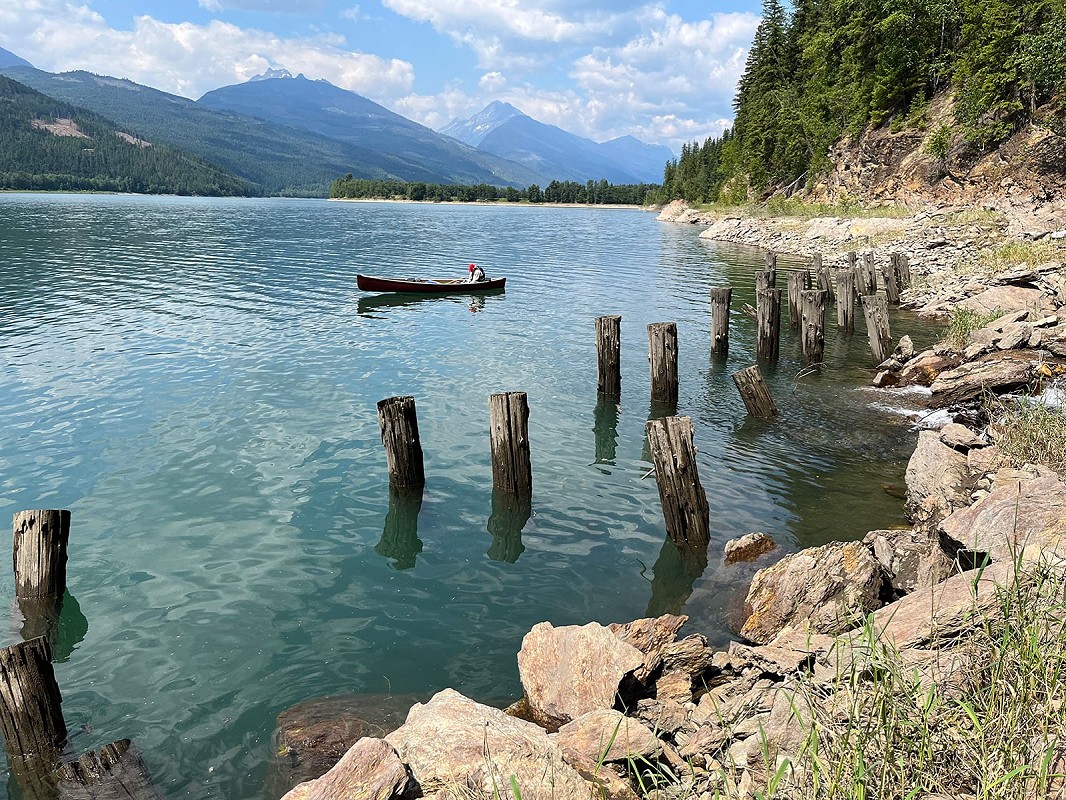
The former railbed is visible at low water, but reservoir levels are not predictable, being managed by an international treaty. Here near Mile 18, piles of a former trestle protrude. Photo © TW Parkin.
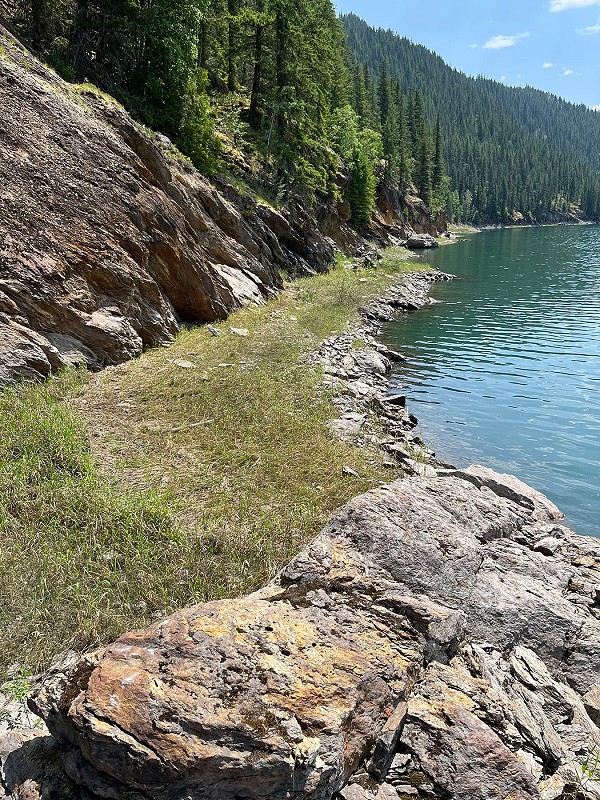
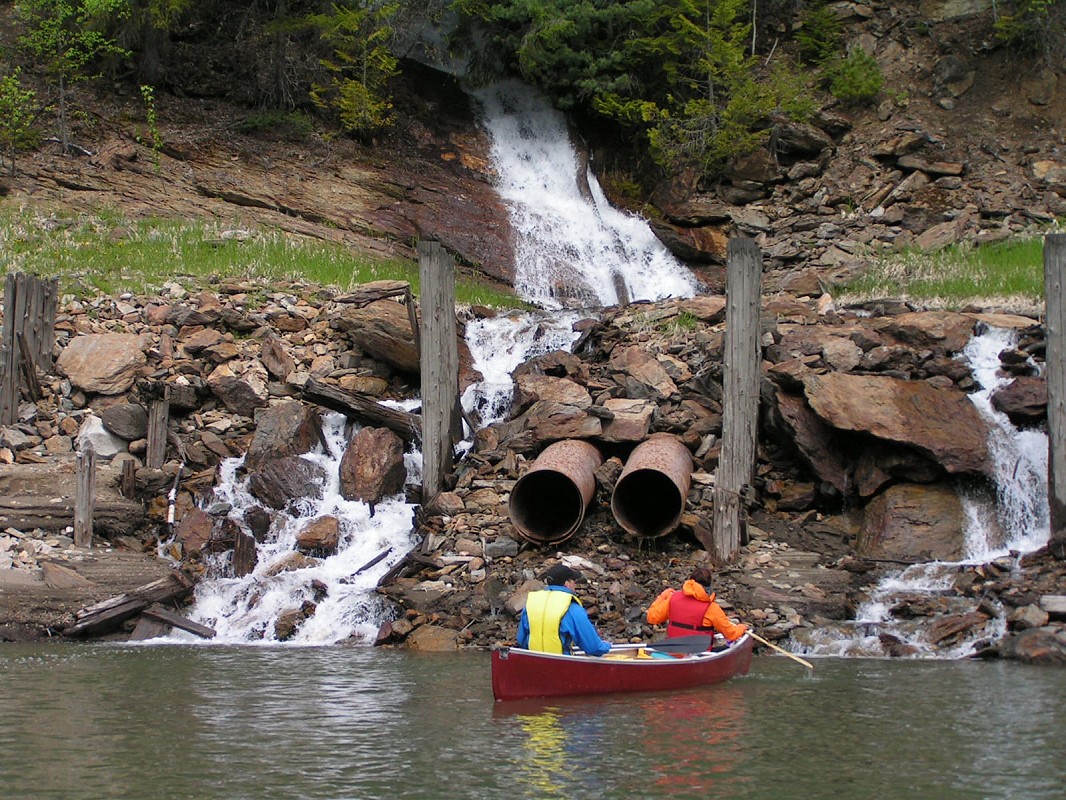
Here a culvert still does duty, despite annual inundation. This part of the reservoir is easily navigated by canoe or trailerable boat, but beware of unexpected shallows and stumps. Photo © B Gadbois.
BC Hydro’s no-salvage policy during the reservoir clearing meant that what couldn’t be burned was buried. Still, there is a cemetery above high water at Arrowhead, and some streets can be discerned with the help of a map. The railway bed and some wood and rock structures still protrude when the lake is low, but the rails, ties, and telegraph wires were removed. Native forest regenerated over much of the town, but domesticated trees still persist—watch for fruit-eating bears in the fall! Access is by boat from Shelter Bay (ferry site on Highway 23 South).
The railway bed and some wood and rock structures still protrude when the lake is low, but the rails, ties, and telegraph wires were removed.
The CPR fleet of passenger steamboats included many venerable names, and it wasn’t uncommon to see three sternwheelers in view simultaneously. Minto was the last in service on the Arrow Lakes in 1954, and suffered a Viking funeral during subsequent reservoir filling. However, her sister SS Moyie operated until 1957, and is well preserved as a National Historic Site at Kaslo, BC (Kootenay Lake). Don’t miss it.
The Revelstoke to Arrowhead branchline is not merely a historical footnote but a testament to the indomitable spirit of those who dared to conquer the rugged terrain of British Columbia’s interior. It reflects the enduring importance of steam transportation in Canada and serves as a reminder of the rich history and scenic beauty that can still be explored today.
This ‘ghost line’ still lives, connecting the past to the present and perhaps inspiring future railfans to explore CP’s pioneering spirit for themselves.
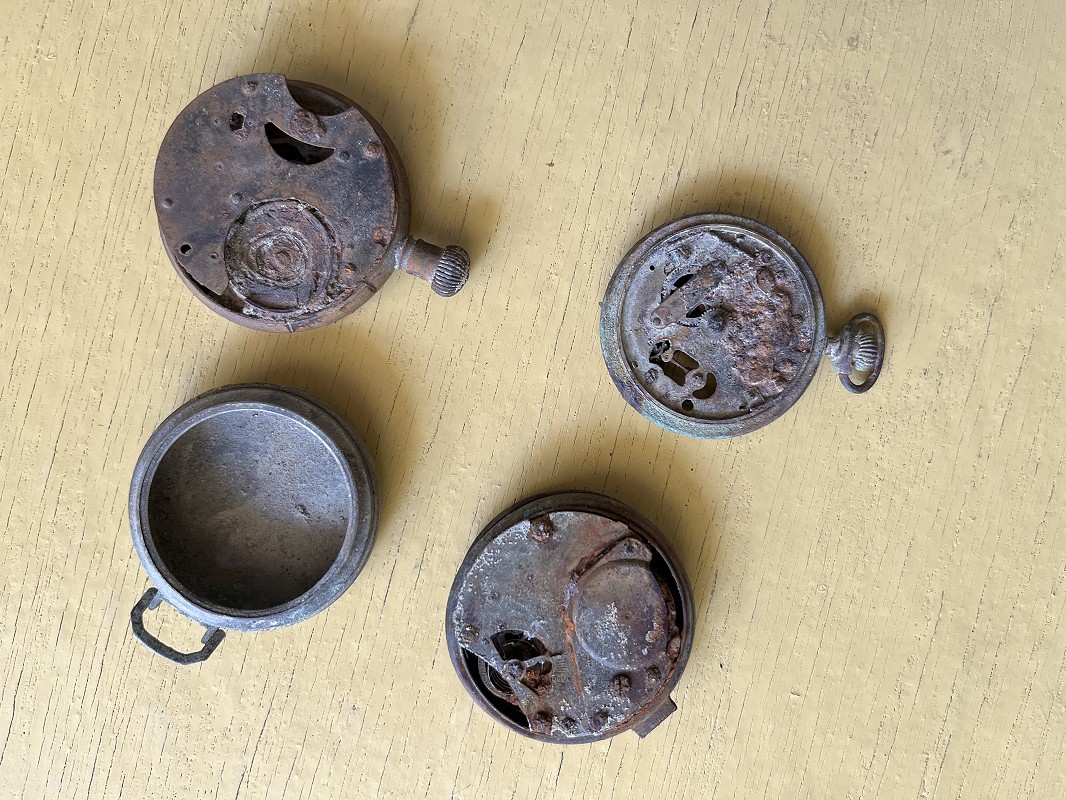
Pocket watches collected at refuse dumps along the roadbed by a local resident indicate that metal detectorists might make additional finds. The fact these were so numerous indicate they were discards of cheap timepieces, formerly owned by maintenance workers. Photo © TW Parkin.
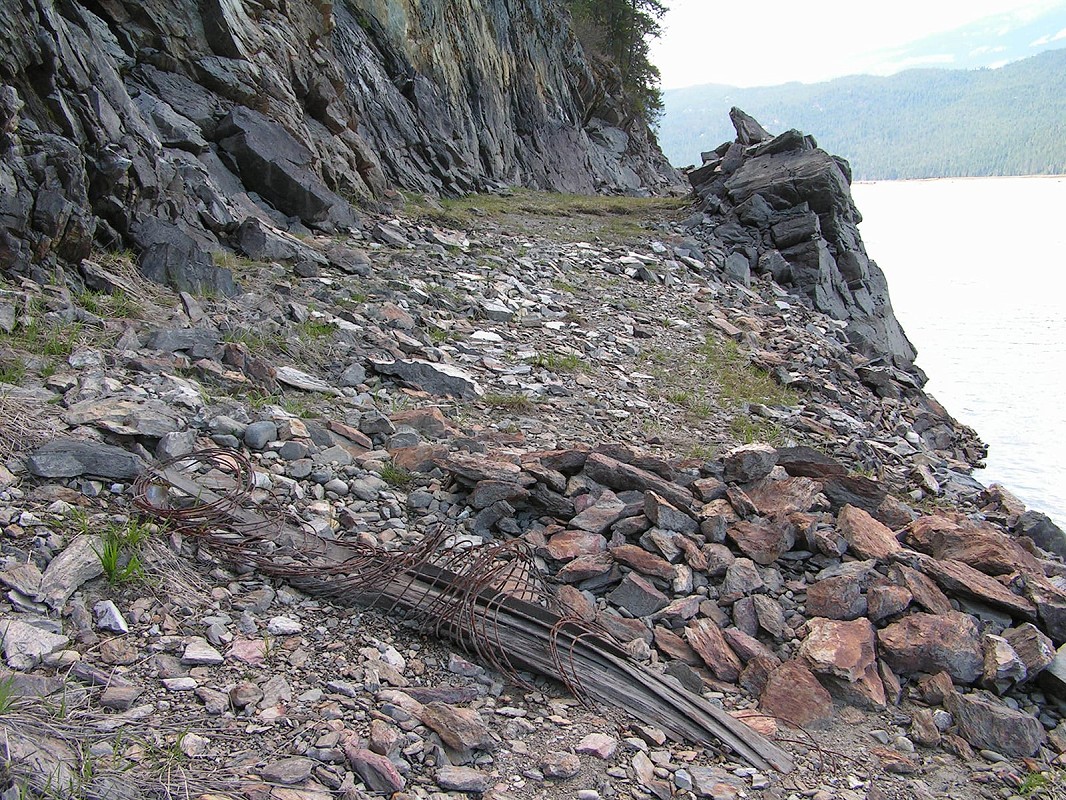
A wire-bound wooden culvert survives, decades after abandonment of the Arrowhead roadbed, here blasted from lakeside cliffs. Photo © B Gadbois.
Credits
Rarely is a story like this the effort of an author alone. I’ve been helped along the way by friends going back 60 years: Brian Gadbois, Gordon Jones, and Ida-Mae Hayek (née Hampton). Ralph Beaumont and Jeri Danyleyko sieved photo archives on my behalf. DJ Meridew provided his own photos and newspaper clippings. Robert D Turner and Mary Ann Zarichuk served as proofreaders. And to dear old Revelstoke, itself . . . thanks for the memories.

Did You Enjoy This Article?
Sign Up for More!
“The Parkin Lot” is an email newsletter that I publish occasionally for like-minded readers, fellow photographers and writers, amateur historians, publishers, and railfans. If you enjoyed this article, you’ll enjoy The Parkin Lot.
I’d love to have you on board – click below to sign up!

